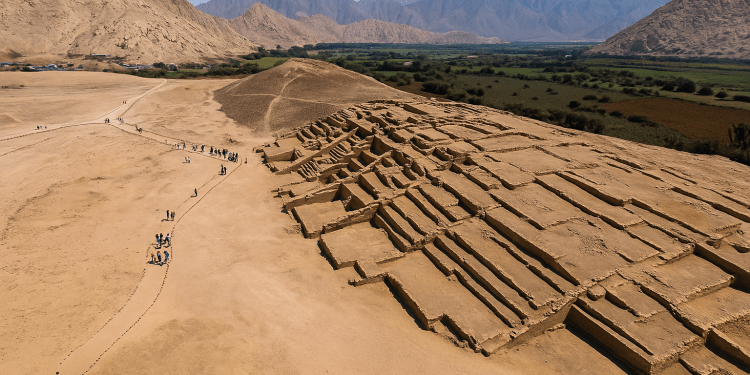Ancient Wonder Reopens to Visitors: Peru’s 3800-Year-Old Penico Citadel Restored
After dedicating eight years to restoration and archaeological research, the Penico citadel site in Peru has finally welcomed visitors once again, shedding light on the country’s diverse cultural heritage. This ancient citadel lay dormant for centuries under layers of soil in Supe Valley before its recent unveiling, marking a significant milestone in Latin American archaeology.
A Lost Chapter of the Americas’ Oldest Civilization
Watch: Ancient Penico Citadel in Peru – Cultural Revival
Penico was previously part of the civilization renowned as the oldest in the Americas. Thriving between 3000 and 1800 BC, it predated the Inca Empire by centuries. Although the extensive Caral complex situated along Peru’s coast 5000 years ago has been subject to research for a long time, Penico signifies a recently unearthed segment in this age-old narrative.
The Rediscovery: Penico as an Ancient Trade Center
In 2017, archaeologists started excavating the Penico site and discovered its significance as a trade center linking Pacific coastal societies with mountainous Andean communities and faraway settlements in the Amazon region.
Strategic Location with Advanced Urban Planning
Penico sits strategically atop a terrace standing at 600 meters (2000 feet) above sea level. The wise builders of old deliberately picked this site to shield the town from seasonal floods while staying close to fertile valleys and flowing rivers.
The Ministry of Culture’s research identified 18 buildings in the Penico complex, from ceremonial spaces to living quarters and public areas, showcasing impressive organizational abilities akin to those seen in ancient civilizations like Mesopotamia and Egypt.
Reviving Ancient Rituals to Celebrate Reopening
The local communities celebrated Penico’s reopening with a vibrant cultural event that included special rituals dedicated to Pachamama, the beloved Andean Earth Mother goddess. Traditional musicians performed on pututu shells, filling the air with echoes from ancient times across the hills.
The reopening event bridged Peru’s present-day essence with its origins, serving as a poignant reminder to both residents and tourists of the enduring legacy of the area’s original urban developers.
Archaeological Insights into Climate and Societal Decline
Archaeologist Ruth Shady, who led excavations at Caral and Penico, highlighted the importance of the site beyond its architecture. Shady suggested that Penico could offer insights into the climate changes that played a role in the downfall of the civilization.
Research indicates that extended periods of drought and environmental decline significantly impacted agricultural practices and led to large-scale migrations in the past. Studying Penico helps us understand how ancient civilizations demonstrated resilience during challenging times.
Architectural Marvels Revealed by Modern Archaeology
The archaeological team shared drone footage showcasing the Penico citadel, featuring a large circular plaza encircled by stone temples and adobe houses. Elaborate bas-reliefs adorn the walls, depicting pututu trumpets and various ceremonial motifs.
Read More: Latest Global Economic Shifts
The Trump 30% Tariff Shockwave: What It Means for Global TradeExcavations revealed clay statues depicting both people and animals, necklaces crafted from seashells, and farming implements. The findings illustrate a civilization that intertwined artistry, spirituality, and practical knowledge to sustain an advanced urban lifestyle.
Penico’s Rising Role in Peru’s Cultural Tourism
Penico now stands alongside iconic sites in Peru such as Machu Picchu, the Nazca Lines, and the ruins of Chan Chan, enhancing tourism in the Huaura province located approximately 180 kilometers north of Lima.
Local officials are optimistic that the rediscovery of Penico will support sustainable tourism, stimulate the local economy, and foster conservation initiatives in the region.
A Timeless Legacy Rediscovered
The revival of Penico holds significance beyond local importance; it marks a moment in global archaeological exploration. Ongoing studies of its structures and artifacts are expected to reveal new perspectives on pre-Columbian civilizations, trade routes, and environmental adaptations.
Penico presents an opportunity for visitors to travel back four thousand years and experience the architectural and cultural brilliance of Peru’s earliest advanced civilizations. Blending history, mystery, and scenic beauty, Penico stands as a timeless symbol of endurance and innovation throughout human history.




